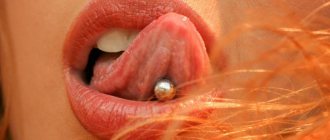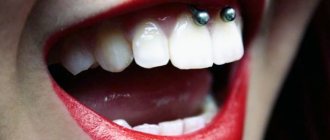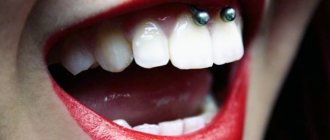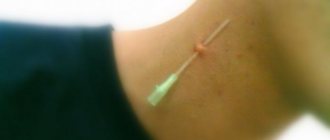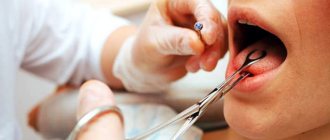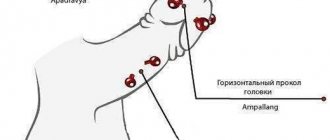Photo from the site: biokrasota.ru
To be completely honest, piercing has become so popular at this time that few of the representatives of modern youth do not have such a bright, but at the same time, not quite ordinary decoration of their own body. The piercing of the genitals or nipples probably causes the most controversy and misunderstanding, but tongue piercing is also a rather controversial issue. Moreover, if the first options are, nevertheless, most suitable for completely extreme types, then tongue piercing is done by many people today, and their reasons for this can be very diverse. It’s worth understanding why people generally do tongue piercing, why they like it, and whether there are contraindications, before making such a rather important decision as piercing.
Types of tongue piercing
There are four types of tongue piercing:
► Vertical - from the frenulum to the palate. Classic and most common puncture.
► Horizontal - the puncture is located on the tip of the tongue, from ear to ear (wide)
► Superficial - the puncture is made across the tongue
► Tongue frenulum piercing – piercing under the tongue
What decorations can be used
The most popular options for tongue decorations include:
- Classic barbells. This is a straight cylindrical rod with decoration on the tips.
- Curved rods. Resembles the shape of a banana.
- Labrets. These are rods on which there is a disk on one side and a round clamp on the other.
- Rings and earrings. Typically used for insertion into the edges and tip of the tongue.
An important criterion is the material of the decoration. It is better to choose hypoallergenic metals such as gold and silver. A fairly universal and inexpensive solution is jewelry made of nickel-plated steel and brass. Another good alternative is a titanium barbell.
You should avoid tongue bars and earrings made of plastic and wood. Despite the very low price, they can contribute to the development of infectious complications and allergic reactions.
Choosing jewelry for piercing
Jewelry for tongue piercing must be made of high-quality material - titanium . Medical steel, gold, silver and other metals contain foreign alloys, which, when in the human body, begin to oxidize, and in the oral cavity this process is much faster, so the consequences after tongue piercing with such jewelry will be very unpleasant. For primary healing, 1.6x22 rods are used (sometimes longer, based on individual measurements of the tongue); a shorter rod can be replaced 2-3 weeks after the puncture. For those who really want a tongue piercing, but have not yet decided, there is a tongue piercing - such jewelry is held on by suction cups or magnets.
At what age can you get a piercing?
At your own discretion, you can undergo the procedure of installing jewelry from the age of 18. But you can get a piercing earlier – from the age of 14. This will require written permission from parents or guardians.
According to medical data, there is no need to rush into getting a piercing. The growing body of a teenager does not tolerate the introduction of foreign objects well, so it is better to postpone such procedures until adulthood.
Puncture procedure
First of all, the master helps you choose jewelry. For initial healing, a 1.6x22 bar is placed in a classic tongue piercing; this is a standard size, which, in case of swelling after the piercing, will prevent the jewelry from digging into the tongue. Wraps are selected for the bar depending on the client’s preferences. Next, the master gives the client to rinse his mouth with octenisept and makes markings, looking at the anatomy of the tongue. After this, sterilized instruments are taken out, the tongue is held with a special round clamp and a puncture is made with a piercing needle, with the help of a taper the jewelry is smoothly inserted and the screw is screwed on. After the piercing, your tongue will hurt and swell, but you shouldn’t be afraid of this; the pain will go away quickly if you follow all the recommendations that the master will give you.
Where can I get a piercing?
Despite the simplicity of the procedure, piercing installation should only be performed in a special salon by a qualified piercer. This is the only way to reliably reduce the risk of complications and side effects.
If the procedure is performed incorrectly at home by an unqualified technician, it is almost impossible to ensure sterility. This can lead to infection of the wound by various pathogens, including such dangerous ones as HIV and hepatitis C.
Tongue piercing care
In order for the piercing to heal well, you need to know how to care for your tongue piercing. Caring for a tongue piercing includes constant treatment of the oral cavity - Lakalut, Asepta or President rinses ; you need to rinse your mouth 4-5 times a day and after each meal and drink. Swelling after tongue piercing lasts at least 4-5 days, so during this time you will have to refrain from active conversations, hard, spicy and salty foods . If you notice that plaque has appeared after your tongue piercing, you should not try to remove it, as you will injure the piercing. After 2-3 weeks, you can change the barbell to a shorter one (downsize).
What not to do after piercing
- Tugging and removing jewelry: the less you disturb the wound, the faster it will heal. If you remove the barbell in the first 2 months, you will not be able to put it back on your own and will have to go to the piercer again.
- Eating too hot, salty and spicy foods: such foods irritate the mucous membrane, and especially the tender and not yet healed tissue in the piercing area. Particles of solid food can get into a fresh puncture, which in turn can cause an infection. Porridge, yoghurt, etc. are best.
- It is undesirable to smoke, drink alcohol and take blood thinning medications: such drugs dilate blood vessels and the wound takes longer to heal. Nicotine generally suppresses the general immune system, increasing the healing time.
Recovery period
The most painful and unpleasant sensations occur during the recovery period. Until the wound surface heals, a person must observe strict restrictions.
On the first day after surgery, the surface of the tongue is very sore and swollen. These changes are normal, pain is the result of soft tissue trauma, and swelling is the cause of damage to lymph flows and blood vessels. The swelling may last for several days.
The wound heals within 2-3 weeks. Complete healing of the wound surface occurs 3-4 months after surgery.
During the first weeks after surgery, you should be careful about your diet. It is important to exclude all spicy, smoked, salty foods from the menu. Dishes should not be hot. It is optimal to eat liquid, fresh, warm food.
Caring for a pierced tongue
The basis of tongue piercing care is the treatment of soft tissues. Every day, twice a day, the wound needs to be treated with antiseptic solutions (Chlorhexidine, a solution of baking soda or potassium permanganate).
For the first 2 weeks after surgery, you need to rinse your mouth after eating. The first days, rinsing is carried out with antiseptic solutions (Chlorhexidine). In the future, you can rinse your mouth with decoctions of medicinal herbs (chamomile, sage, calendula).
Barbell care
For 2 weeks after the tongue piercing, you need to clean the barbell daily with a toothbrush. After this time, it is necessary to regularly remove the “decoration”, thoroughly clean it of surface contaminants and disinfect it in a Chlorhexidine solution.
Piercing and gum disease
As we have already written, insufficient hygiene and low-quality metal lead to the development of bacteria. And an excessive amount of bacteria in the mouth leads to gum diseases such as periodontitis.
or
gingivitis
.
The specialists who conducted the study noted tissue degeneration and displacement or loosening of teeth even in very young patients, for whom such diseases were not typical.
How to pierce your tongue at home
You need to choose a well-lit room so that there is a place to lay out the instrument. Use only disinfected clamp, needle and earring. Wash your hands with soap and wipe with a disinfectant solution. Perform actions wearing disposable sterile gloves:
- Treat your mouth with an antiseptic.
- Choose a puncture site in the middle, closer to the tip of the tongue, there are no large blood vessels there.
- Pinch the tongue with tongs, then use a special needle to pierce it strictly perpendicular to the surface.
- Use a catheter to insert the earring.
- How to feed cucumbers after planting in the ground
- Eighth month of pregnancy
- Pityriasis rosea in a child - treatment, signs and symptoms, photo
Pros and cons of piercing
Piercing has a number of advantages.
- The procedure is painless - pain during the puncture is practically not noticeable and is quite tolerable.
- Quick disguise - there are situations when an earring sticking out of the tongue is not at all appropriate, for example, during business negotiations or at an official reception. In this case, you can purchase a flesh-colored barbell.
- Psychological component - in some situations, piercing helps a person to assert himself, become more confident in himself and his own appearance.
- Easy removal - if you are tired of the stud, just remove it, and the hole will gradually close up.
Despite the large number of advantages, punctures have their downsides.
- Changes in diction - a person may begin to have a slight lisp or have difficulty pronouncing some sounds.
- Long healing after the procedure - after about 1-2 months, the tongue will get used to the foreign body and completely adapt to it.
- Disapproving reaction from relatives - unfortunately, not all close people will accept your choice, but on the contrary, they will dissuade you and ask you to get rid of such jewelry,
- Increased salivation - manifests itself in most cases.
- The risk of ingesting cloves increases during sleep, when a person does not control himself.
the puncture is almost painless
two tone piercing
Purpose of piercing
People who decide to have their tongue pierced have different goals. It is widely believed that the presence of an earring in the soft tissue of the tongue improves sexual satisfaction in a partner. Young girls often decide to have their tongue pierced simply to become fashionable. Some people pierce a part of their body in order to show others that they belong to a certain subculture.
Tongue piercing helps people stand out “among the crowd,” to indicate that they are not like everyone else, and to prove their own uniqueness and individuality.
Contraindications and possible consequences - can everyone have their tongue pierced?
Despite its wide popularity, piercing of this part of the body is not accessible to everyone. There is a whole list of contraindications that prohibit intentional injury to an organ:
- inability to take the healing period seriously: you should not get a piercing if you currently do not have the time and suitable conditions to regularly treat the wound, rinse and wash,
- pregnancy period: during this period, the risk of critical infection poses a truly serious threat, so it is simply unreasonable to expose yourself and the child to danger once again,
- allergy to antibiotics: in this case, the potential complication of infection can be fatal,
- allergy to metals,
- poor blood clotting,
- mental illness,
- epilepsy,
- oral diseases,
- autoimmune diseases, hemophilia, diabetes mellitus - all these are strict contraindications to intentional damage to the oral mucosa. If you have any health problems, it would be a good idea to consult your doctor.
Important! In Russia, piercing is allowed for persons who have reached the age of majority - 18 years. In some cases, it is possible to carry out the procedure from the age of 16, but only with the written official consent of the parents1.
Tongue diseases can cause poor wound healing
In addition to many contraindications, tongue piercing has a number of serious complications. Of course, today in medical centers and decent salons all risks are reduced to a minimum, but the likelihood of encountering a serious problem still remains. So, an infection can penetrate into the wound or the metal can provoke an allergic reaction. If the technician performs inept actions, bleeding may occur or a nerve may be damaged, which will lead to partial loss of sensitivity. The most dangerous possible consequence is infection through instruments - hepatitis, HIV and other dangerous diseases.
Clean the area two to three times daily
Regular cleansing is the best way to get rid of bacteria and prevent further irritation. Morning and night cleaning are ideal. You can also rinse the puncture site with saline solution after each meal.
With pre-prepared saline solution
A ready-made saline solution is the easiest and most effective way to clean any piercing. You can buy them over-the-counter (OTC) at a piercing shop or local pharmacy.
To clean your piercing:
- Dampen a clean cloth or durable paper towel with the solution. Avoid using cotton balls, tissues, or thin towels as they may get caught in the jewelry and cause irritation to the piercing.
- Gently wipe the cloth or towel on each side of the jewelry. Do not rub or touch as this will cause irritation.
- Repeat this process as many times as needed. There should be no crust on the decoration or around the hole.
How bad is it for teeth?
If you get a tongue piercing, will it damage your teeth? Yes, premature destruction of enamel and dentin is more than real, because the earring located in the mouth constantly has a mechanical effect on the surrounding tissues. Owners of fashion accessories often have the following problems:
- the appearance of cracks and chips on the enamel: the front units of the row suffer the most, because they bear the main “blow”,
- increased sensitivity and abrasion of hard tissues,
- the risk of developing caries and other dental pathologies increases.
Expert opinion
Elina Ruslanovna Dzagurova
Specializations: Dentist-therapist
Experience: 11+
“If there is a piercing in the mouth, then various restorations carried out in the smile area in order to improve aesthetics serve less. Especially with ceramic, composite or plastic coating. Decoration damages their surface, leaving scratches and cracks as easily as on the surface of natural teeth.”
Contraindications
Absolute restrictions on the intervention:
- age under 18 years;
- pregnancy and lactation period;
- chronic diseases in the acute stage;
- infectious diseases, even a common cold;
- epileptic seizures;
- psychological disorders;
- low blood clotting;
- alcohol and drug intoxication;
- weakened immune system;
- diabetes;
- hemophilia.
Tongue piercing is unacceptable in case of weakened immunity, mental disorders and serious chronic diseases
It is not advisable for anyone under 18 years of age to have their tongue pierced.
Consequences of wearing piercings for the oral cavity in general
Tongue or lip piercing means a permanent hole in the mouth through which harmful microorganisms can circulate. Hard-to-remove food particles can get inside it and onto the earring itself (rings, rods), which gradually rot. Accordingly, bacterial plaque accumulates in this area, provoking various inflammatory processes. Increased plaque accumulation leads to persistent bad breath.
The presence of a ring in the mouth is perceived by the body as a “foreign object,” which causes significant discomfort, especially at the adaptation stage. During a conversation and even chewing food, the jewelry constantly comes into contact with the mucous membranes and causes microtrauma to the delicate tissues.
Piercing in the mouth can have different consequences
Piercing can lead to difficulties with proper chewing of food and impaired diction. Many people experience increased salivation. Some, on the contrary, are concerned about severe dryness and the development of xerostomia. In clinical practice, there are cases when the sensitivity of the punctured muscle organ completely disappears, and as a plus, the taste of food is distorted.
There are also a number of unpleasant, but few expected consequences - allergies, the development of glossitis and even galvanic syndrome. As a rule, jewelry is created from base metals, which tend to gradually oxidize under the influence of the oral environment. As a result, the following reactions are possible: the constant presence of a metallic taste in the mouth, soreness of the muscle organ, swelling, itching and irritation of the mucous membrane, the appearance of a rash (bubbles, pimples, ulcers). As for galvanism, it can develop in people who, in addition to metal piercings, have crowns, dentures and braces in their mouths, which also contain metal.
On a note ! For piercing, barbells or studs are usually used - earrings consisting of a straight rod and several twists (fixing elements). Carefully ensure that the system elements are tightly connected to each other and tighten them periodically. Otherwise, there is a risk of individual elements unwinding, swallowing them, and even suffocation.
The history of piercing
For the first time, residents of African tribes and Polynesia began to practice the procedure of piercing various parts of the body. The Maasai were the first to introduce various decorations into their ears and lips. At that time, it was believed that the larger the size of the jewelry in the body, the greater the “weight” a person had in the tribe.
Navel piercing first appeared in Egypt. Women loved this procedure very much. The presence of a hole in the navel area of the Egyptian woman indicated that she belonged to “high society.”
In Tsarist Russia, sailors preferred to pierce their earlobes and wear voluminous earrings. Such a “symbol” meant that the person crossed the equator or belonged to the Cossack family. Later, starting in the 80s, it became fashionable for rappers to pierce their earlobes.
Nose piercing first appeared in India. The presence of a septum piercing (a puncture of the nasal septum) in a woman indicated her marital status, that is, that the girl was married.
Nipple piercings were done by warriors of Ancient Rome. An earring in a man's nipple indicated his masculinity, courage and determination. Only the strongest and bravest warriors had the right to have nipple piercings. Those with nipple earrings regularly competed in strength and courage. In order not to damage the “decoration”, special fabric capes were worn over the earrings.
The ancient Aztecs and North American tribes first began piercing their tongues. They carried out the procedure consciously, since it was considered a magical rite that helped to reunite with the Gods. The protruding blood on the tongue was considered sacred; it served as a means of calming the Spirits.
These days, piercings have completely different purposes. By piercing various parts of the body, people want to show their individuality, attract attention or stand out. For some, piercing is a way to feel new emotions, to prove to themselves that they can overcome pain and, as it were, move to a “new level of development.”
How is a smiley piercing done, does it hurt?
The procedure begins with choosing a frenulum decoration - the smile piercing is one of the few types of piercings that can accommodate almost any type of jewelry . Next, the master begins to prepare the instruments and sterilize them. After preparing the instruments and the workplace, the master treats the oral cavity with a special antiseptic (most often it is octenisept); markings for this puncture are not required. The master lifts the lip slightly and pierces it at an angle of 90 degrees to the frenulum (a clamp is most often not used to avoid deformation of the frenulum). The puncture takes literally a couple of seconds , then the master carefully inserts the jewelry without removing the needle. The procedure is very quick and virtually painless, but it all depends on your pain threshold. One thing we can say for sure, piercing the frenulum is quick, you won’t even have time to realize everything. That's it, the procedure is over, now you are the owner of a rather unusual, but aesthetic puncture!
Do not play with or remove jewelry
Moving the jewelry can increase pain and irritation and lead to the appearance of new bacteria in the holes.
The only time you should touch it is during cleansing.
It may also be tempting to take out your jewelry, but this may actually do more harm than good.
Removing the jewelry will not only cause additional irritation, but will also allow the new piercing to be covered up. This can trap bacteria and allow the infection to spread beyond the puncture site.
